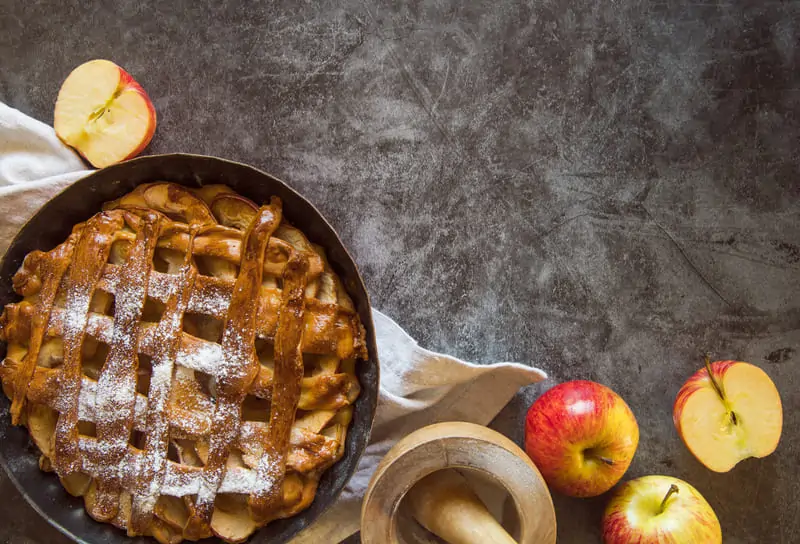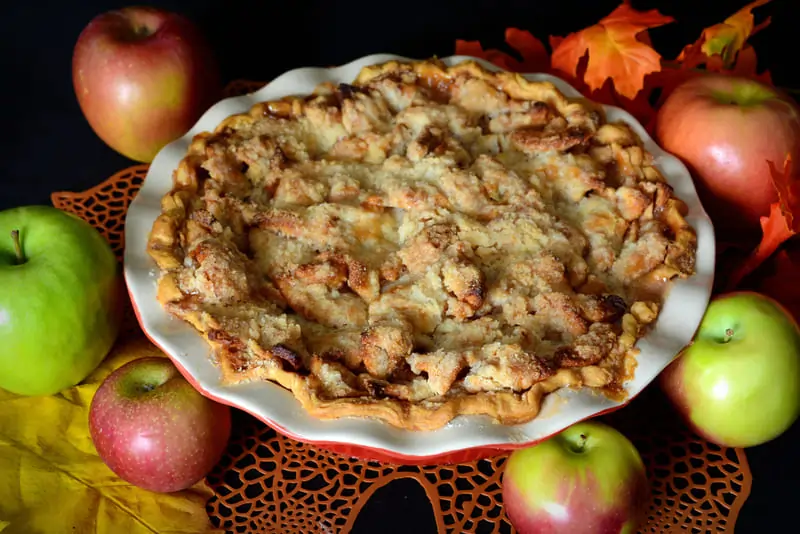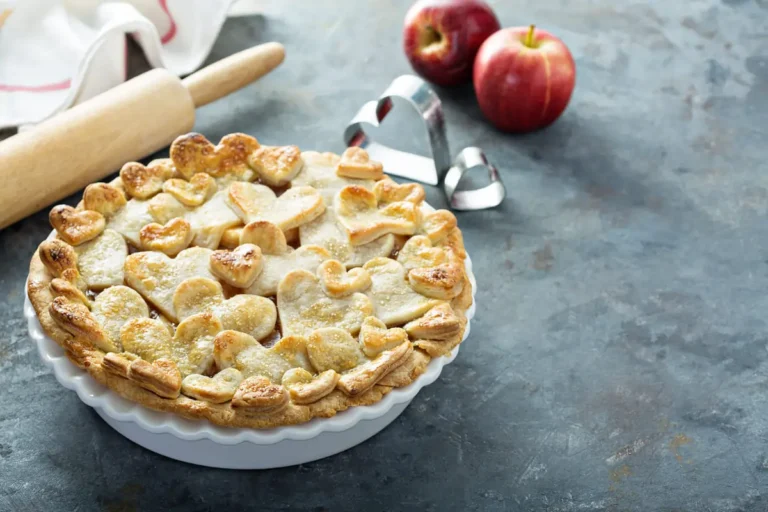The secret to a perfect apple pie lies not just in the crust but in the combination of apples you choose. The right mix of sweet and tart apples can elevate the flavor, while the texture of firm apples ensures that each bite is just right. This guide explores the best apple combinations for a pie that’s flavorful, balanced, and unforgettable.
Understanding the Role of Apples in Pie
The Science Behind Baking Apples
When apples are baked, their texture softens, and their natural sugars caramelize, creating that distinct apple pie aroma. However, not all apples bake the same way. Some retain their structure, while others turn to mush, making it essential to choose varieties that complement each other. For an in-depth look at apple baking properties, check out this guide to baking apples.
Key Apple Characteristics for Pie
- Firmness: Apples like Granny Smith retain their shape and offer a slight crunch.
- Sweetness: Varieties like Honeycrisp and Golden Delicious add natural sweetness.
- Tartness: Apples such as Jonagold or Braeburn provide a tangy contrast.
For a detailed approach to balancing flavors, read this guide on perfect apple combinations for pies, which also covers managing moisture levels in fruit fillings.
Top Apple Varieties and Combinations for Pie Baking
Selecting the right apples is essential for creating a pie with balanced flavor, texture, and structure. Certain varieties work better for baking because they hold their shape and develop rich flavors under heat. Mixing different types of apples adds depth, ensuring a dynamic and satisfying pie. For tips on maintaining pie structure, explore our article about prebaking crusts for cherry pies.
1. Recommended Apple Varieties
When choosing apples for pies, it’s important to focus on varieties that balance sweetness and tartness while maintaining a firm texture during baking.
- Granny Smith:
- Why It’s Great: Known for their sharp tartness and exceptional firmness, Granny Smith apples are a go-to choice for bakers. They balance sweet fillings and pair beautifully with spices like cinnamon and nutmeg.
- Pro Tip: Use Granny Smith apples as the base for most pies, then mix with sweeter varieties for added complexity.
- Honeycrisp:
- Why It’s Great: Honeycrisp apples are naturally sweet and juicy, making them ideal for balancing tart apples like Granny Smith. They maintain their crisp texture even after baking, adding a satisfying bite to each slice.
- Pro Tip: Add a sprinkle of lemon juice to Honeycrisp apples to enhance their natural brightness.
- Golden Delicious:
- Why It’s Great: With their soft, mellow sweetness, Golden Delicious apples are perfect for adding a smooth flavor to pies. They hold their shape well but become tender and creamy when baked.
- Pro Tip: Pair Golden Delicious with tart or spicy varieties for a well-rounded flavor.
- Jonagold:
- Why It’s Great: A hybrid of Golden Delicious and Jonathan apples, Jonagold offers the best of both worlds—a sweet-tart flavor with subtle hints of honey.
- Pro Tip: Use Jonagold apples in pies where you want a slightly tangy flavor without overpowering sweetness.
- Braeburn:
- Why It’s Great: With a spicy-sweet flavor and firm texture, Braeburn apples are excellent for pies with complex flavor profiles. They bring depth and balance to any apple combination.
- Pro Tip: Add a pinch of cardamom or ginger to your Braeburn-based pie for an extra layer of warmth.
For more details on how apple textures influence pie structure, check out our comprehensive pie-making guide.
2. Ideal Apple Combinations for pie

Combining different apple varieties ensures that your pie has a range of flavors and textures. By mixing tart and sweet apples, you can avoid pies that are too sugary or overly tangy.
- Granny Smith + Honeycrisp:
- Why It Works: This classic combination blends the tartness of Granny Smith apples with the natural sweetness and crunch of Honeycrisp. The result is a perfectly balanced filling with a delightful texture.
- Pro Tip: Add a touch of brown sugar to emphasize the sweetness of Honeycrisp while keeping the tartness in check.
- Golden Delicious + Jonagold:
- Why It Works: Mildly sweet and tangy, this pairing creates a pie with smooth, honeyed notes and a soft texture. Ideal for those who prefer a less tart dessert.
- Pro Tip: Sprinkle a little lemon zest over the filling to enhance the natural flavors.
- Braeburn + Jonagold:
- Why It Works: The spicy-sweetness of Braeburn apples combined with the sweet-tart balance of Jonagold creates a bold and layered flavor profile.
- Pro Tip: Toss the apples with a mixture of cinnamon, nutmeg, and allspice to complement the spice notes in Braeburn apples.
- Granny Smith + Fuji:
- Why It Works: Granny Smith’s tartness and firm texture pair beautifully with Fuji’s crisp juiciness and natural sweetness, creating a unique and vibrant filling.
- Pro Tip: Use this combination for pies with lattice crusts, allowing the filling’s bright flavors to shine through.
Learn more about enhancing fruit pies with the right apple combinations in our step-by-step pie recipe guide.
Why Mixing Apples Matters
Using a blend of apple varieties adds layers of flavor, ensuring your pie isn’t overly sweet or one-dimensional. It also helps achieve a pleasing texture, with some apples softening into a creamy base while others retain a bit of crunch. This balance elevates the overall pie-eating experience, making each bite a harmonious blend of tastes and textures.
For bakers looking to perfect their pie technique, explore our tips on managing moisture in fruit pies to ensure your apple pie remains structurally sound and visually stunning.
Expert Tips for Preparing Apples for Pie
The way you prepare apples for your pie directly impacts its flavor, texture, and overall success. From peeling techniques to balancing sweetness, these expert tips will help you create a perfect apple filling every time. For additional insights on simplifying dessert preparation, explore our guide on banana bread preparation techniques, which highlights flavor balance and efficiency.
1. How to Prep Apples for Pie

Properly preparing apples ensures even cooking, vibrant flavors, and a visually appealing pie filling. Attention to detail during this step sets the foundation for a flawless dessert.
Peeling and Slicing
- Removing the apple peel is crucial to avoid a chewy texture in your pie. While the peel contains fiber, it can become tough and disrupt the soft consistency of the filling when baked.
- Slice the apples evenly to promote uniform cooking, preventing some pieces from turning mushy while others remain undercooked.
- Pro Tip: Aim for slices about ¼ inch thick—thin enough to cook through but thick enough to hold their shape.
Preventing Browning
- Once apples are sliced, they oxidize quickly, leading to browning that can affect their appearance and flavor.
- Toss the apple slices in lemon juice immediately after cutting. The acidity not only maintains their color but also adds a subtle brightness to the filling.
- Pro Tip: Use about 1 tablespoon of lemon juice per 3–4 cups of sliced apples for effective results.
Adjusting Sugar
- The natural sweetness of apples varies by variety, so it’s important to adjust the sugar in your recipe accordingly. Tart apples like Granny Smith may require more sugar, while sweeter varieties like Fuji or Honeycrisp need less.
- Balancing the sugar ensures your pie isn’t overly sweet or too tangy, letting the natural flavors of the apples shine through.
- Pro Tip: Start with ½ cup of sugar for 6 cups of apples, then taste the mixture and adjust as needed before assembling the pie.
For more on balancing flavors in fruit-based desserts, visit our step-by-step pie preparation guide.
2. Mistakes to Avoid for the Best Apple Combination for Pie
Avoiding common pitfalls can elevate your apple pie from good to exceptional. Paying attention to these details will help you avoid problems like a watery filling or overly mushy texture.
Using Only One Apple Variety
- Relying on a single apple type can result in a pie with flat, one-dimensional flavor. Combining different varieties, such as tart Granny Smith with sweet Honeycrisp, adds depth and balance to the filling.
- Pro Tip: Mix at least two varieties for a more dynamic taste and texture. Learn about ideal apple combinations to create the perfect mix for your pie.
Overcooking Apples
- Overcooking apples can break down their structure, leaving you with a mushy filling that lacks texture. This is especially problematic for pies with lattice tops or open designs, where the filling is more exposed to heat.
- To avoid this, monitor your baking time carefully and use apples that hold their shape well under heat, such as Braeburn or Jonagold.
- Pro Tip: Slightly underbaking the pie allows the apples to finish softening as the pie cools.
Skipping Thickening Agents
- Failing to include a thickener like cornstarch, tapioca, or flour can lead to a runny filling as the apples release their juices during baking. A proper thickener binds the liquid, ensuring the pie slices cleanly without excess moisture pooling at the bottom.
- Pro Tip: Use 1–2 tablespoons of cornstarch or 3 tablespoons of flour for every 6 cups of apples. For a glossy finish, consider using tapioca or ClearJel.
For more on managing pie filling consistency, explore our tips on using thickeners effectively.
Enhancing Your Apple Pie Combination
By mastering these preparation techniques and avoiding common mistakes, you can ensure that your apple pie is not only visually appealing but also bursting with flavor and texture. From peeling and slicing to balancing sugar and choosing the right apples, each step contributes to a pie that delights the palate. For more inspiration and dessert ideas, visit our banana bread preparation techniques guide to explore creative ways to enhance your baking repertoire.
FAQs about Apple Combination for Pie
What apples should I avoid for pie?
Avoid overly juicy apples, like Red Delicious, as they can lead to a soggy crust. To prevent a soggy bottom crust, learn about prebaking pie crusts for fruit pies, which is an excellent solution for maintaining crust structure.
What’s the best ratio for mixing apple varieties?
A good starting point is a 1:1 ratio of tart to sweet apples, but you can adjust based on your taste preferences. If you enjoy experimenting with flavor profiles, read this guide on balancing fruit flavors in pies, which also includes tips for managing sweetness and tartness.
Can I use frozen apples for pie?
Yes, but thaw and drain them thoroughly to prevent excess liquid from ruining the crust. To handle frozen fruits effectively, explore this article on thickening pie fillings, which provides helpful insights for moisture control.
How do I know if apples are fresh?
Fresh apples are firm to the touch, have vibrant skin, and emit a pleasant aroma. For more baking tips, check out this guide on simple and efficient dessert preparations, which emphasizes the importance of fresh, high-quality ingredients.
Final Thoughts
Crafting the perfect apple pie begins with selecting the right apple combination. By mixing tart and sweet varieties, you can create a pie with depth, flavor, and the perfect texture. Don’t be afraid to experiment with your favorite combinations to make a pie that’s uniquely yours. With these tips, your next appel pie will be a guaranteed success! If you’re interested in experimenting with other baking techniques, you might also enjoy reading about how to thicken pie fillings.

